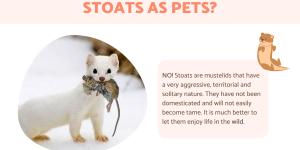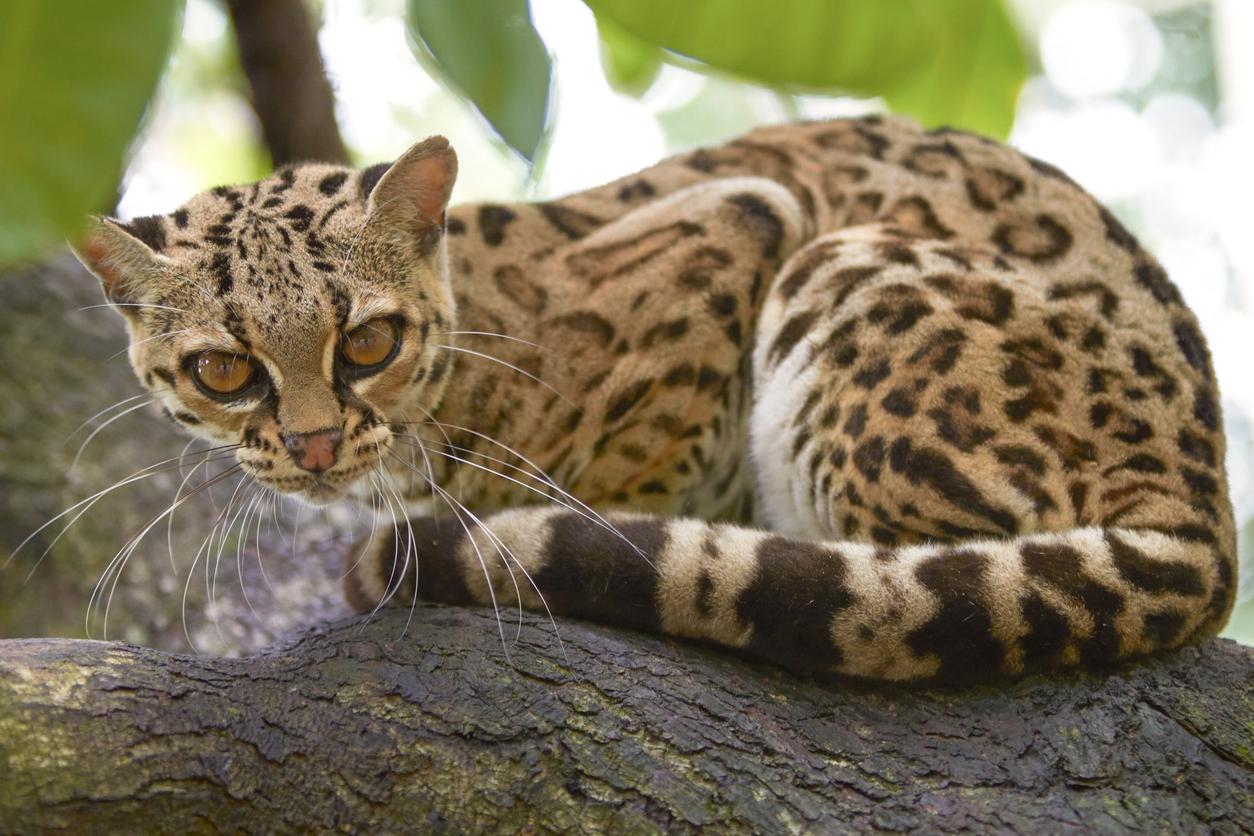The Ocelot as a Pet: Everything you Need to Know


The Leopardus paradalis, also known commonly as ocelot, became a popular pet among Americans during the 1950's and 1960's, with even celebrities such as Catalan surrealist painter Salvador Dalí adopting them as pets. This leopard-like feline is actually one of the smallest types of wildcat. It is found in several areas of all the American continent, including Texas, Arizona, Peru or Mexico.
The IUCN (International Union for Conservation of Nature) has now cataloged it as as species of least concern, although the truth is that their increasing loss of natural habitat has affected the species severely. Despite these facts, you may ask yourself if you can own an ocelot cat as a pet. At AnimalWised we'd like to give you all the facts so you can make a formed decision. Read on to know everything about the ocelot as a pet.
The ocelot's physical traits
The ocelot (Leopardus pardalis), from the Leopardus genus and the Family Felidae ,is a medium sized wildcat native to mostly Central and South America. Their most characteristic feature is their spotted coat which is similar to that of a Leopard. Short and smooth, it has been the main cause for their decline, as their fur was highly praised in the past and were thus hunted down. The color of their fur can vary from tawny yellow to gray. They are around 22 and 39 inches long on average and can weigh up to 35 pounds. It is precisely their size that makes the fairly dangerous to keep as a pet for families, as they have been known to harm small children on occasions.
Another of the traits that make the ocelot an exceptional feline is their big, beady eyes, that have a perfectly round shape and have very distinct darker markings around them that make ocelots even more appealing to the eye. Their ears are not pointed like most common pet cats, but are rounded at the top. As they are carnivores they have 28 to 30 sharp teeth.
On average, they have a lifespan of around eight to twelve years of age.
The ocelot's nature
The first thing to learn about when considering an ocelot as a pet is how they behave in nature in order to assess if it is fine to keep it at home.
There is a difference between wild and feral cats as, although all feline, they descend from a different evolutionary branch and the latter have not been domesticated. The actual word says it: wild cats are wild, and thus need to live outdoors. A minimum outdoor surface of 800 square meters is required in order for the ocelot to live happily and adequately.
Ocelots, as most felines, are crepuscular animals, meaning they are at their most active during dusk and dawn. During the hours when this cat is awake an average of 12 to 14 h, their main activity is hunting. Thus, other domestic animals in the surrounding areas can be prey for the ocelot if you have it at home. Dogs or chickens are commonly hunted by ocelots in semi-urban areas.
On the other hand, you should know that, like most New World cats, the ocelot's feces have a distinct strong smell, as well as a highly damp texture. They are also prone to marking territory and can even do so in the places where they sleep. An ocelot at home will mimic this behavior too unless taught from a very young age.
Talking about baby Ocelots, these tend to have infantile or juvenile behaviors for longer than most felines, as they will usually stay with their mother for longer, which is why separating a baby ocelot from its mother at a young age can be a huge mistake that can derive into behavioral problems. For one, a baby ocelot craves for a lot of attention. If they do not payed attention to, they will emit a loud noise, as if they were throwing a tantrum until their mother pays attention to them.
Ocelots in heat also have several behaviors that do not favor keeping them as pets. Female ocelots in heat produce a constant growl and will try to rub their scent against any object they find in their way, their calls, as you can imagine, are much louder than those made by common female cats. On the other hand, once male ocelots have mated, they may be less affectionate with people.
All in all, the ocelot's behavior makes it very dependent from their owner, which is why a potential ocelot carer will have to be highly committed to an ocelot's care, as we'll comment further on.

The ocelot's diet
As mentioned above, the ocelot is a natural carnivore. In the wild, they will hunt for small rodents such as mice or rats as well as several types of birds and even fish[1]. If you need to feed an ocelot, then their diet should be similar to those of cats. Thus, apart from organ meat, they will need to supplement it with taurine and calcium. You should also make sure you don't give them any of the forbidden foods for cats, as they can be equally harmful for ocelots.
Ocelot specific care
As you have read above, an ocelot is not the most convenient pet to have at home, even though they may seem cute and exclusive, we have to remember their wild nature so, if you happen to find an injured ocelot in your back yard, work at a rescue center or similar, make sure you follow these basic care guidelines to look after an ocelot:
In general, ocelots are fairly sociable although they cannot be trained basic commands, so it will be a challenge to stay on top of them when it comes to discipline.
Ocelot kitten care
As mentioned previously, ocelots take longer to separate from their mothers, as they take longer to wean and are very dependent on their mother. Sucking fingers of their carers is something usual, as it reminds them of their mother, although you should avoid this behavior to avoid them from thinking that hands are actually toys. To teach them not to suck on fingers, make sure you distract them from this activity by offering them a treat or redirecting their attention towards play. You can use boomer balls, kongs (under constant supervision) or other toys suitable for cats to do so.
The ocelot's space
Although they can be indoors, ocelots also need their outdoor space. In general, they should have a space of at least 800 square meters. To prevent obesity in this type of feline, you should offer them an enriched space with all of their favorite features such as high climbing poles, platforms and plenty of plants (make sure they are not toxic for them). They will also need some aquatic features too, as they love water, so add a pond where they can play too.
Don't spay
Due to several programs for the conservation of ocelots in certain countries, it's not advisable to spay. Remember the ocelot is an endangered species, so there are other things to take into account when making this decision. Contact your department of conservation and put them into contact with your vet so you can all take an informed decision.
Toilet needs
So where should an ocelot go to do their business? Although some can actually be trained to use litter, although other methods will be easier to teach your pet. We should also warn you that this animal's nature may lead them to swallowing cat litter and cause intestinal problems, another reason why this is not recommended.
Instead, a more recommended method is to teach them to do their business on newspapers.
Ocelots in the house
Ocelots love jumping, climbing and digging, which is why you will need to be extra careful if you let your ocelot inside your house. Make sure you get rid of any objects on display that this beautiful feline could accidentally drop when leaping around and any objects susceptible to nibbling and biting, as this is one of their favorite past-times. Remember to make sure you don't have any toxic plants for cats in the house either.
Biting
As mentioned above, ocelots are prone to biting, which is why you should keep small children away from them. As many other small felidae, they will usually target specific areas of the body when attacking, such as the groin, elbow, armpit or neck. They are also extremely fast and agile, so beware. By this we do not mean that the ocelot is a violent animal, but if they are not socialized, they will still act according to their nature.
Veterinary care
You should take an ocelot to an exotic pets vet that is specialized in ocelots. Regular vets will not have the knowledge to treat them, so make sure your vet has the knowledge they need. If you cannot find anybody specialized, it is best to ask your regular vet to contact a nearby sanctuary or zoo to get advice from professionals.

Ocelot trade and legal issues
Thinking about buying an ocelot? You'd better start forgetting about it. You should always remember the ocelot is an endangered species, so trade is totally illegal. The Convention on International Trade in Endangered Species (CITES) clearly states in appendix I[2] that it is a violation of the Lacy Act to ship an Ocelot to the United States and the person will thus be committing felony.
Regarding the possession of ocelots in the United States, each state has their own regulations on exotic cat ownership, which is why you should be properly informed beforehand[4].
If you suspect of illegal trade in the US, you can contact the department of Conservation to deal with the issue.
The European Union also states CITES as the reason why an ocelot cannot go through customs in any country of the EU[5].
The ocelot's endangerement
Hunting for their fur and trade has been one of the main issues for the conservation of the ocelot during the past century. Although the fur trade was banned decades ago, some illegal trade is still affecting this species. Luckily, hunting of this species is totally banned in Argentina, Brazil, Bolivia, Colombia, Costa Rica, French Guiana, Guatemala, Honduras, Mexico, Nicaragua, Panama, Paraguay, Suriname, Trinidad and Tobago, United States, Uruguay and Venezuela.
The ocelot's main threat nowadays is loss of habitat and its fragmentation. The reason is basically anthropogenic, logging and poaching the main human activities that affect the ocelots natural habitat. Moreover, a study by the Journal of Wildlife Management pinpointed vehicle collisions as one of the main causes of mortality in ocelots in the US [5] , which is directly related to their loss of habitat and the ocelot's nocturnal transient nature.
So what can we do about this? Due to their drop in numbers the only way of conserving this species is through the assistance of mankind. Thus, creating green paths and ensuring habitat conservation of wild ocelots for their correct development will be key to help this beautiful feline.
If you want to read similar articles to The Ocelot as a Pet: Everything you Need to Know, we recommend you visit our What you need to know category.
1 http://www.tandfonline.com/doi/abs/10.1076/snfe.37.3.207.8564
2 https://www.cites.org/eng/app/appendices.php
3 http://ec.europa.eu/environment/cites/info_souvenirs_en.htm
4 https://bigcatrescue.org/state-laws-exotic-cats/
5 http://www.bioone.org/doi/abs/10.2193/0022-541X(2005)069%3C0255:SASOMI%3E2.0.CO%3B2









